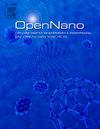具有磁回收性能的Fe3O4/BiOCl光催化剂对罗丹明B染料的光响应去除
Q2 Pharmacology, Toxicology and Pharmaceutics
引用次数: 0
摘要
采用简易超声法成功制备了Fe3O4/BiOCl二元光催化剂。磁性Fe3O4/BiOCl用于罗丹明B (RhB)染料的太阳能解毒。制备的二元光催化剂主要显示BiOCl的衍射峰。BiOCl和Fe3O4/BiOCl的能隙分别为3.37 eV和2.55 eV。与原始BiOCl相比,Fe3O4/BiOCl光催化剂的荧光强度较低,表明载体分离率提高。该结果与磁性Fe3O4/BiOCl光催化剂的光催化活性的提高有良好的相关性。光照90 min后,光催化效率达到100%。RhB染料的降解符合一级动力学模型,最大速率常数为0.0113 min-1。二元光催化剂在第五次循环使用后仍保持良好的光降解活性。捕获技术揭示了光生电子和超氧阴离子自由基在RhB解毒过程中起关键作用。本研究为制备具有磁性可分离性质的光活性半导体催化剂提供了一种很有前途的方法,用于RhB染料在水相中的解毒。本文章由计算机程序翻译,如有差异,请以英文原文为准。
Fe3O4/BiOCl photocatalyst with magnetic recovery property for solar-light-responsive removal of Rhodamine B dye
Binary Fe3O4/BiOCl photocatalyst was fabricated successfully via a facile ultrasonic route. The magnetic Fe3O4/BiOCl was used for solar-light-driven detoxification of Rhodamine B (RhB) dye. The prepared binary photocatalyst displayed mainly the diffraction peaks of BiOCl. The energy gap of BiOCl and Fe3O4/BiOCl was 3.37 eV, and 2.55 eV, respectively. The Fe3O4/BiOCl photocatalyst revealed lower fluorescence intensity, compared to the pristine BiOCl, indicating the enhanced carrier separation rate. The result corelates well with the improvement in photocatalytic activity of the magnetic Fe3O4/BiOCl photocatalyst. High photocatalytic efficiency of 100% was achieved after 90 min of sunlight irradiation. The degradation of RhB dye fits nicely with the first-order kinetic model revealing the maximum rate constant of 0.0113 min–1. The binary photocatalyst still maintains the excellent photodegradation activity after the fifth cycle of use. The trapping technique reveals that photogenerated electrons and superoxide anion radicals play a key role in RhB detoxification. The present work provides a promising way to generate the sunlight-active semiconducting catalyst, with magnetic separable property, for detoxification of RhB dye in an aqueous phase.
求助全文
通过发布文献求助,成功后即可免费获取论文全文。
去求助
来源期刊

OpenNano
Medicine-Pharmacology (medical)
CiteScore
4.10
自引率
0.00%
发文量
63
审稿时长
50 days
期刊介绍:
OpenNano is an internationally peer-reviewed and open access journal publishing high-quality review articles and original research papers on the burgeoning area of nanopharmaceutics and nanosized delivery systems for drugs, genes, and imaging agents. The Journal publishes basic, translational and clinical research as well as methodological papers and aims to bring together chemists, biochemists, cell biologists, material scientists, pharmaceutical scientists, pharmacologists, clinicians and all others working in this exciting and challenging area.
 求助内容:
求助内容: 应助结果提醒方式:
应助结果提醒方式:


